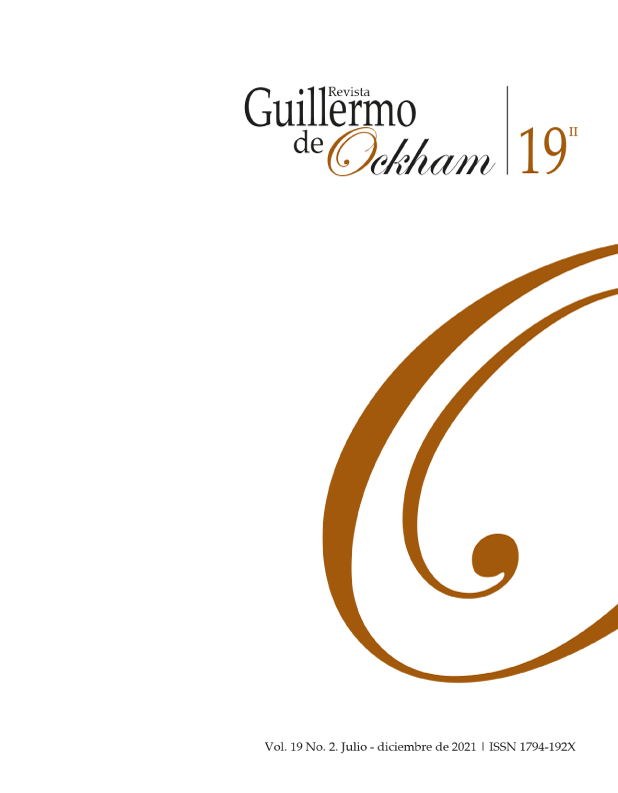The Revista Guillermo de Ockham provides an immediate and open access to its content, based on the principle of offering the public a free access to investigations to provide a global interchange of knowledge.
Unless otherwise established, the contents of this journal has a license with Creative Commons Attribution-NonCommercial-NoDerivatives 4.0 International (CC BY-NC-ND 4.0) http://creativecommons.org/licenses/by-nc-nd/4.0/
- Attribution: You must give appropriate credit, provide a link to the license, and indicate if changes were made. You may do so in any reasonable manner, but not in any way that suggests the licensor endorses you or your use.
- NonCommercial: You may not use the material for commercial purposes.
- NoDerivatives: If you remix, transform, or build upon the material, you may not distribute the modified material.
- No additional restrictions: You may not apply legal terms or technological measures that legally restrict others from doing anything the license permits.
Abstract
This article reviews some of the most significant contributions of education to a culture of peace after the Cold War. It initially aims to address the challenge faced by peace within the framework of the neoliberal, patriarchal hegemonic project that has made violence and fear its source of legitimation and, on the other hand, the essential role that education plays in the reconstruction of the social fabric in a postwar conflict-and-reconciliation setting. In both cases, issues such as affectivity, solidarity, the recognition of diversity and the conflict that results from being different, as well as the need to rethink our relationship with nature and the environment in terms of sustainable development, are put forward as both relevant and priority in education for a culture of peace.
Keywords:
References
Chomsky, N., y Ramonet, I. (2002). Cómo nos venden la moto. Barcelona: Icaria editorial S. A.
Dietrich, W. (2014). A Brief Introduction to Transrational Peace Research and Elicitive Conflict Transformation. Journal of Conflictology, 48-57.
Dietrich, W. (s.d. de s.d. de s.d.). La paz como concepto cultural, experiencia energética y reconocimiento transracional. Obtenido de Los hilos del mundo: https://loshilosdelmundo.files.wordpress.com/2012/11/dietrich_la-paz-como-concepto-cultural-copy.pdf
Echavarría, J. (2014). Mapeo elicitivo de conflictos: una herramienta práctica para el trabajo por la paz. Obtenido de Universitat Innsbruck: https://www.uibk.ac.at/peacestudies/downloads/peacelibrary/echavarria_ecm_una-herramienta-practica_trabajo_paz.pdf
Fisas, V. (1998). Una cultura de paz. En: https://escolapau.uab.cat/img/programas/cultura/una_cpaz.pdf
Freire, P. (1993). Pedagogía de la esperanza. Un encuentro con la pedagogía del oprimido. México: Siglo XXI.
Galtung, J. (2014). La geopolítica de la educación para la paz. Aprender a odiar la guerra, a amar la paz y a hacer algo al respecto. Revista de Paz y Conflictos. Universidad de Granada, Volumen 7. pp. 9-18.
Galtung, J. (2016). La violencia: cultural, estructural y directa. Cuadernos de estrategia, 147-168.
Guerrero, H. y Sánchez, J. (2015). Una pedagogía de los sentimientos. Investigación y Desarrollo, 58-90.
Habermas, J. (s.d.). Nuestro breve siglo. Archivo Chile, 13.
Infante, A. (2013). El papel de la educación en situaciones de posconflicto. Estratégias y Recomendaciones. Hallazgos. Universidad Santo Tomás, 223-245.
Jares, X. (2002). Aprender a convivir. Revista Interuniversitaria de formación del profesorado, 79-92.
Jiménez, F. (2019). Educación neutral y educación para la paz neutra. Revista de Cultura de Paz, Vol 3, 367-387.
Jiménez, F. (2019). Una educación social que busca una cultura de paz. Revista d´Intervenció Socioeducativa, Vol. 72 Págs. 13-34 . En: https://www.raco.cat/index.php/EducacioSocial/article/view/356229/452099
Mayor, F. (2010). Fundación Cultura de Paz. Obtenido de https://fund-culturadepaz.org/wp-content/uploads/2021/03/Historia-de-la-Cultura-de-Paz.pdf
Mayor, F. (2003). Educación para la paz. Educación, XX1, 17-24.
Nussbaum, M. (2014). Emociones políticas: ¿Por qué el amor es importante para la justicia? Paidós.
Pecaut, D. (2015). Una lucha armada al servicio del statu quo social y político. En: https://www.humanas.unal.edu.co/observapazyconflicto/files/5714/6911/9376/Version_final_informes_CHCV.pdf
Rawls, J. (1995). Teoría de la justicia. Fondo de Cultura Económica.
Santos, B. (1998). De la mano de Alicia. Lo social y lo político en la postmodernidad. Bogotá: Ediciones Uniandes.
Zuleta, E. (2015). Sobre la guerra. Revista Universidad de Antioquia, (319). En: https://revistas.udea.edu.co/index.php/revistaudea/article/view/22402.

 Perfil Google Scholar
Perfil Google Scholar































